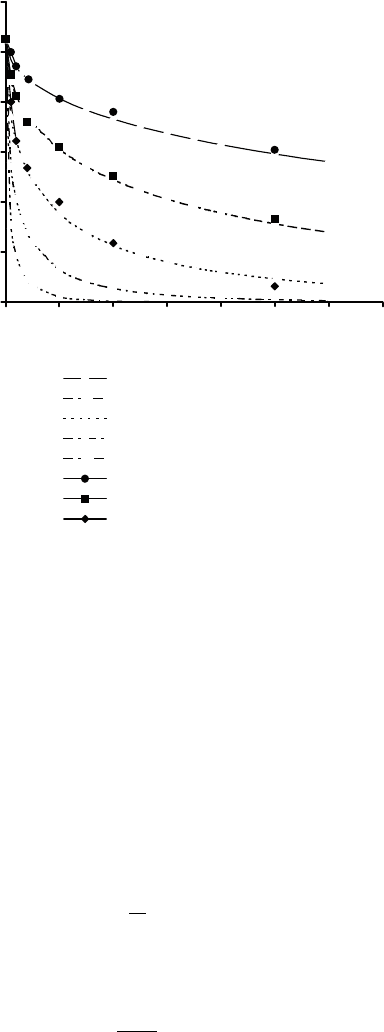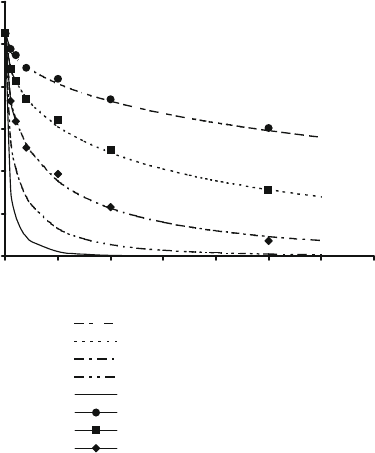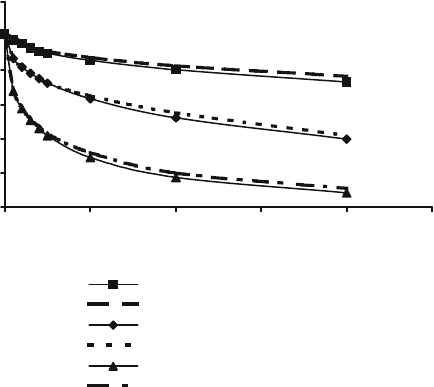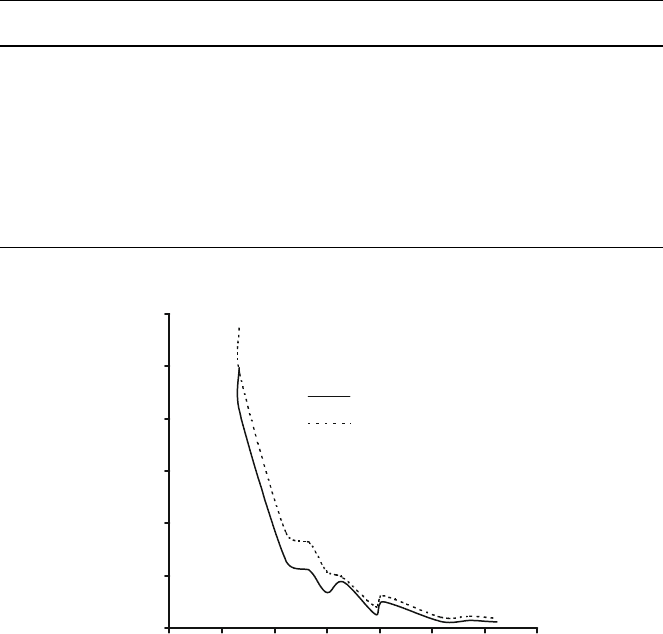Jackson Mark. Machining with Abrasives
Подождите немного. Документ загружается.


The data comparing Lundin’s experimental results, the author’s experimental
results, and the dissolution model are shown in Table 7.4. When the data are plotted
as the logarithm of (ln [m/M]/t
1/2
) versus the reciprocal of absolute temperature,
1/T, then all data fits a straight-line relationship. The gradient was calculated to
be 33,374, the constant B, using two data points. Lundin’s experimental gradient
gave a value of 32,962 using the least squares method, and 34,000 for the present
work. The corresponding activation energies for both systems are 131 kcal/mole
for Lundin’s work [7], and 135 kcal/mole for the present work, respectively.
Figures 7.25 and 7.26 show the effects of time on residual quartz content at different
temperatures according to (7.40) together with comparative experimental data. A
comparison was made with dissolution models published in the literature. One of
the earliest models was derived by Jander [15]. The equation can be expressed:
Fig. 7.24 X-ray diffraction spectrum of a vitrified bonding system showing the interplanar
distances of crystallographic planes of mullite, quartz and calcium fluoride. Scan rate was 2
/
min. Used with permission copyright Springer (2007)
7 Nanogrinding 335

1
ffiffi
½
p
31 Z
2
¼
C
1
D
r
2
t (7.41)
where Z is the volume of quartz that has been dissolved, r is the original particle
radius, and D is the diffusion coefficient for the diffusing species. This equation can
be transformed into mass fractions using Archimedes’ law, thus,
1
ffiffi
½
p
3
m
M
2
¼ C
2
t (7.42)
Table 7.4 Residual quartz content of a sintering bonding system at various vitrification
temperatures
Temp. (
C) Time (h)
Lundin’s exp.
result (wt.%)
Exp. result
(wt.%)
Jackson and
Mills’
[12] result (wt.%)
1,200 (1,473 K) 1 24.1 24.2 24.2
1,200 1 24.7 24.3 24.2
1,200 1 26.1 24.8 24.2
1,200 2 23.7 23.8 23.4
1,200 2 23.6 23.9 23.4
1,200
*
2 23.4 23.4 23.4
1,200 4 21.3 22.2 22.3
1,200 8 20.3 20.9 20.8
1,200 18 19.0 18.5 18.6
1,200 18 18.9 18.6 18.6
1,200 48 15.2 15.1 14.9
1,250
(1,523K)
1 22.7 22 22.1
1,250
*
2 20.6 20.6 20.6
1,250 4 18 18.5 18.6
1,250 8 15.5 16 16.2
1,250 18 12.6 12.5 12.6
1,250 48 8.3 7.8 8.0
1,300
(1,573K)
0.5 22.6 20.4 20.6
1,300 0.5 21 20.9 20.6
1,300 1 20 18.3 18.6
1,300 2 16.1 15.9 16.2
1,300 4 13.4 12.8 13.2
1,300 8 10 9.7 9.9
1,300 18 5.9 5.8 6.1
1,300 50 1.6 1.8 2.3
1,300 120 0.3 0.2 0.6
Lundin’s [7] experimental data are compared with the author’s experimental data and
the model [12]
The asterisk indicates values used for deriving the constants used in the theoretical model
336 M.J. Jackson and J. P. Davim

where C is a constant dependent on soaking temperature and initial particle size of
quartz. Krause and Keetman [16 ] expressed the dissolution of quartz as a function
of isothermal firing time, viz,
M m ¼ C
3
ln t (7.43)
where M is the initial quartz content, and m is the residual quartz content after time,t.
The unit of time here is seconds such that after 1 s of firing the residual quartz content
is equal to the initial quartz content. Monshi’s dissolution model [17] can be trans-
formed into the following equation assuming isothermal firing conditions:
ln
m
M
no
¼C
6
ffiffi
t
p
(7.44)
Jackson and Mills’ model [12] for isothermal firing conditions is transformed into:
ln
m
g M
¼C
7
ffiffi
t
p
(7.45)
0
5
10
15
20
25
30
0 10203040506070
Soaking time (h)
Residual quartz content (wt.%)
1200 C (model)
1250 C (model)
1300 C (model)
1350 C (model)
1400 C (model)
Lundin's experimental data (1200 C)
Lundin's experimental data (1250 C)
Lundin's experimental data (1300 C)
Fig. 7.25 Effect of time on residual quartz content of a sintering bonding system according to
Jackson and Mills’s model [12], and compared with Lundin’s experimental data [7]. Used with
permission copyright Springer (2007)
7 Nanogrinding 337

where g is the ratio of densities of b- and a -quartz. Constants for all the equations
presented here are calculated using quartz mass fraction data after 18 h’ firing. The
constants are dimens ioned in seconds. The equations shown were compared with
experimental data generated by Lundin [7] for a clay-based material cont aining
40 wt.% kaolin, 40 wt.% quartz, and 20 wt.% feldspar. According to the trans-
formed equations, the mass fraction of quartz can be calculated as follows,
Jander’s model [15]
m ¼ 41:9 1 1:55 10
6
t
3=2
(7.46)
Krause and Keetman’s model [16]
m ¼ 41:9 2:58 ln tðÞ (7.47)
Monshi’s model [17]
m ¼ 41:9 e
4:510
3
ffi
t
p
(7.48)
Jackson and Mills’ model [12]
1200 C (model)
1250 C (model)
1300 C (model)
1350 C (model)
1400 C (model)
Authors' experimental data (1200 C)
Authors' experimental data (1250 C)
Authors' experimental data (1300 C)
0 10203040506070
Soaking time (h)
0
5
10
15
20
25
30
Residual quartz content (wt.%)
Fig. 7.26 Effect of time on residual quartz content of a sintering bonding system according to
Jackson and Mills’s model [12] and compared with the authors’ experimental data. Used with
permission copyright Springer (2007)
338 M.J. Jackson and J. P. Davim

m ¼ 41:73 e
4:510
3
ffi
t
p
(7.49)
The transformed equations are then tested using data provided by Lundin [7].
Referring to Table 7.5, it can be shown that the mass fraction of quartz obtained
using the equations derived by Jander [15] and Krause and Keetman [16] did not
agree with Lundin’s experimental results [7].
The results obtained using Monshi’s model [16] are in much better agreement
compared to Lundin’s data. However, the results obtained using Jackson and Mills’
model [11] is more accurate at predicting the mass fraction of quartz remaining
owing to the differences in the density of quartz. After long periods of heat
treatment, the model predicts lower magnitudes of mass fractions of quartz whe n
compared to Lundin’s experimental results [6].
7.5.5.5 Fusible Bonding Systems
The constants, A and B, for the fusible bonding system wer e determined using time
and temperature couples at 2 and 10 h and were calculated to be, 5.2 10
8
and 33,205, respectively. The dissolution equation then becomes,
m
T;t
¼ 10:06 exp 5 :2 10
8
t
1=2
e
33;205=T
hi
(7.50)
Equation (7.50) is used to compare the experimentally determined mass fraction of
quartz remaining after heat treatment with the predicted values. The calculated mass
fraction of quartz remaining after a period of heat treatment is calculated using the
Table. 7.5 Residual quartz content for different soaking times at 1,300
C for a sintering bonding
system composed of 40 wt.% kaolin, 40 wt.% quartz, and 20 wt.% feldspar (Lundin’s mixture
number M21 [7]) compared with other dissolution models
Time (h)
Lundin’s exp.
data [7] Jander [15]
Krause and
Keetman [16] Monshi [17]
Jackson and
Mills [12]
0 41.9 41.9 0.00 41.9 41.9
0.5 35.9 41.72 22.55 34.61 34.76
1 32.8 41.54 20.76 31.97 32.12
2 29.2 41.19 18.97 28.58 28.72
4 23.2 40.49 17.18 24.39 24.51
8 19.5 39.11 15.39 19.49 19.59
18 13.3 35.72 13.30 13.30 13.36
24 10.7 33.74 12.56 11.13 11.19
48 6.9 26.18 10.77 6.43 6.51
120 3.6 7.85 8.96 2.17 2.17
190 2.7 0.00 7.22 1.00 1.01
258 2.0 0.00 6.43 0.54 0.55
7 Nanogrinding 339

equation derived by Jackson and Mills [12]. The results of the dissolution model
compare well with the experimental data over short periods of time. Howeve r, over
longer periods of heat treatment the model tends to become less accurate (Fig. 7.22).
A comparison was made with published dissolution models. The equations shown
were compared with experimental data at 1,050
C. The equations shown were
compared with experimental data at 1,050
C. According to the transformed equa-
tions, the mass fraction of quartz can be calculated as follows (Fig. 7.27):
Jander’s model [15]
m ¼ 10:1: 1 3:44 10
6
t
3=2
(7.51)
Krause and Keetman’s model [16]
m ¼ 10:1 0:59 ln tðÞ (7.52)
Monshi’s model [17]
m ¼ 10:1 e
6:410
3
ffi
t
p
(7.53)
Jackson and Mills’ model [12]
0
2
4
6
8
10
12
0 1020304050
Soaking time (h)
Residual quartz content (wt.%)
Authors' experimental data (950 C)
950 C (model)
Authors' experimental data (1000 C)
1000 C (model)
Authors' experimental data (1050 C)
1050 C (model)
Fig. 7.27 Effect of time on residual quartz content of a fusible bonding system according to
Jackson and Mills’s model [12] and compared with the author’s experimental data. Used with
permission copyright Springer (2007)
340 M.J. Jackson and J. P. Davim

m ¼ 10:06 e
6:3710
3
ffi
t
p
(7.54)
With reference to Table 7.6, it can be shown that the mass fraction of quartz
obtained using the equations derived by Jander [15] and Krause and Keetman
[16], did not agree with the experimental results at 1,050
C. The results obtained
using Monshi’s model [17] are in much better agreement compare d to the experi-
mental data. However, the results obtained from Jackson and Mills’s mode l are
more accurate at predicting the mass fraction of quartz remaining owing to the
differences in the density of quartz. After long periods of heat treatment, the model
Table 7.6 Residual quartz content for different soaking times at 1,050
C for a fusible bonding
system compared with other dissolution models
Time
(h)
Exp.
data
Jander model
[14]
Krause and Keetman
model [15]
Monshi’s
model [16]
Jackson and Mills’
model [11]
0 10.1 10.1 0 10.1 10.1
1 6.84 9.91 5.23 6.88 6.86
2 5.79 9.72 4.82 5.87 5.86
3 5.13 9.54 4.58 5.21 5.19
4 4.7 9.36 4.41 4.7 4.68
5 4.28 9.18 4.28 4.28 4.28
10 3.2 8.28 3.87 2.99 3
20 2 6.6 3.46 1.81 1.82
40 1.1 3.62 3.04 0.89 0.89
0
10
20
30
40
50
60
Abrasive Number
Grinding Ratio
High quartz content
Low quartz content
13001200
11001000
900800
700
600
Fig. 7.28 Effect of the abrasive number on the grinding ratio for a high-quartz content and a low
quartz-content bonding system. Used with permission copyright Springer (2007)
7 Nanogrinding 341
predicts slightly lower magnitudes of mass fractions of quartz when compared to
the experimental results.
The dissolution of quartz during heat treatment has a significant effect on the
wear of vitrified grinding wheels. Figure 7.28 shows the effect of usin g a high and a
low quartz content bonding system on the wear of vitrified corundum grinding
wheels grinding a large number of tool steel materials [18]. The classification of
tool steels is in the form of an abrasive hardness number, which is a weighted
average of the number of carbides contained within the tool material. As shown in
Fig. 7.28, the grinding ratio, or G-ratio, is a measure of the efficiency of the grinding
wheel. It is the quotient of the volume of workpiece material removed and the
volume of the wheel material removed. The figure demonstrates the effectiveness of
reducing the quartz content of the bonding system of porous nanogrinding tools.
7.6 Conclusions
This chapter has shown that nanogrinding is in its embryonic stages of development
and a fundamental understanding has already started in the area of computational
analysis. However, the real breakthrough discovery will in the area of the develop-
ment of machine tools capable of nanogrinding and its practical application to
machining a variety of engineering materials in addition to machining optical
materials and materials used in semiconductor applications. There is also a require-
ment to manufacture high quality grinding tools that will be required to continu-
ously maintain form and shape characteristics in addition to very small surface
roughness values. A form of continuo usly dressed, or sharpened, processes will be
required in order to make the nanogrinding process highly desirable to micro and
nanomachinists.
References
1. Rentsch R (2009) ‘Nanoscale Cutting’, published in ‘Nano and Micromachining’, Edited by
Davim, J. P., and Jackson, M. J., ISTE-Wiley Publishers, London, pp. 1–26.
2. Zhao Q, Dong S, and Sun T (2001) High Technol. Lett., 7, (3), 84–89.
3. Ahao QL, Dong S, and Sun T (2001) Key Eng. Mater., 202–203, 315–350.
4. Jackson MJ (2001) J. Manuf. Process., 3, 17–28.
5. Timoshenko SP, and Goodier JN (1970) Theory of Elasticity, 3rd Edition – International
Student Edition, McGraw-Hill Kogakusha Ltd., Tokyo, pp. 109–113, and pp. 139–144.
6. Loladze TN (1967) Requirements of tool materials, Proceedings of the Eighth International
Machine Tool Design and Research Conference, Pergamon Press, pp. 821–842.
7. Lundin ST (1959) Studies on Triaxial Whiteware Bodies, Almqvist and Wiksell, Stockholm,
Sweden.
8. Storch W, Ruf H, and Scholze H (1984) Ber. Deut. Keram. Ges., 61, 325.
9. Binns E (1962) Sci. Ceram., 1, 315.
10. Ford WF, and White J (1951) Trans. J. Br. Ceram. Soc., 50, 461.
342 M.J. Jackson and J. P. Davim
11. Kirchoff G, Pompe W, and Bahr HA (1982) J. Mater. Sci., 17, 2809.
12. Jackson MJ, and Mills B (1997) J. Mater. Sci., 32, 5295–5304.
13. Alexander IE, and Klug HP (1948) Anal. Chem., 20, 886.
14. Khandelwal SK, and Cook RL (1970) Am. Ceram. Soc. Bull., 49, 522–526.
15. Jander W (1927) Z. Anorg. U. Allgem. Chem., 163, 1–30.
16. Krause P, and Keetman E (1936) Sprechsaal, 69, 45–47.
17. Monshi A (1990) Investigation into the strength of whiteware bodies, Ph.D. Thesis, University
of Sheffield, United Kingdom.
18. Jackson MJ (December 1995) A study of vitreous-bonded abrasive materials, Ph.D. Thesis,
Liverpool John Moores University, United Kingdom.
7 Nanogrinding 343

